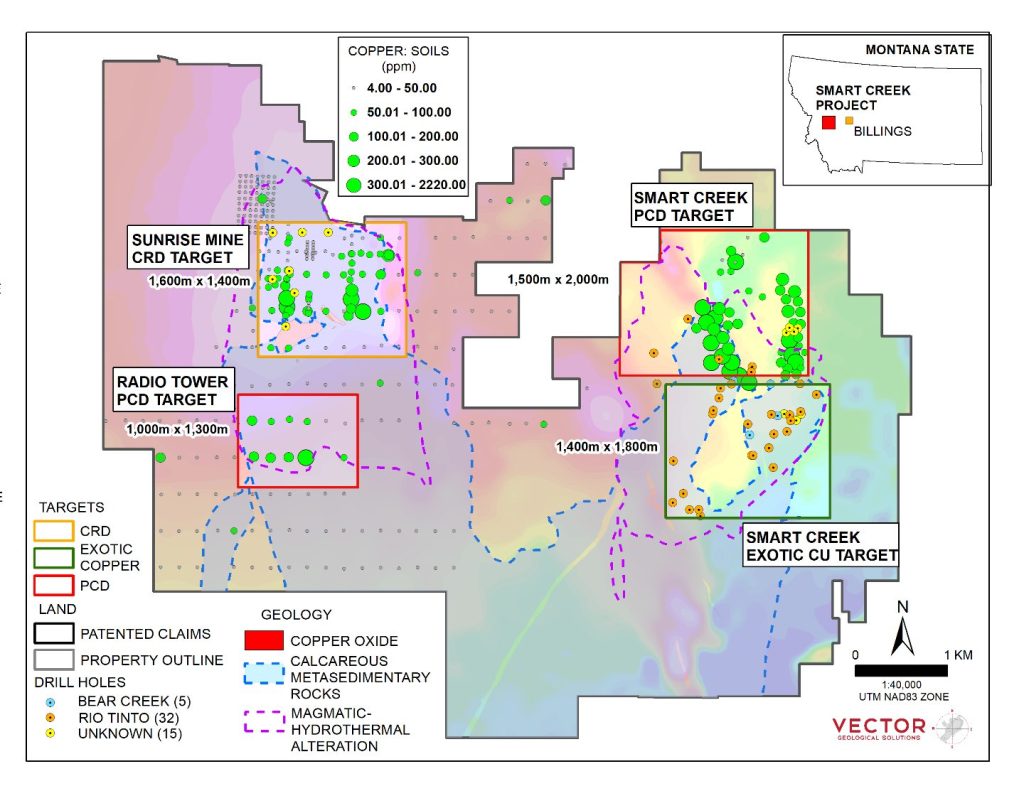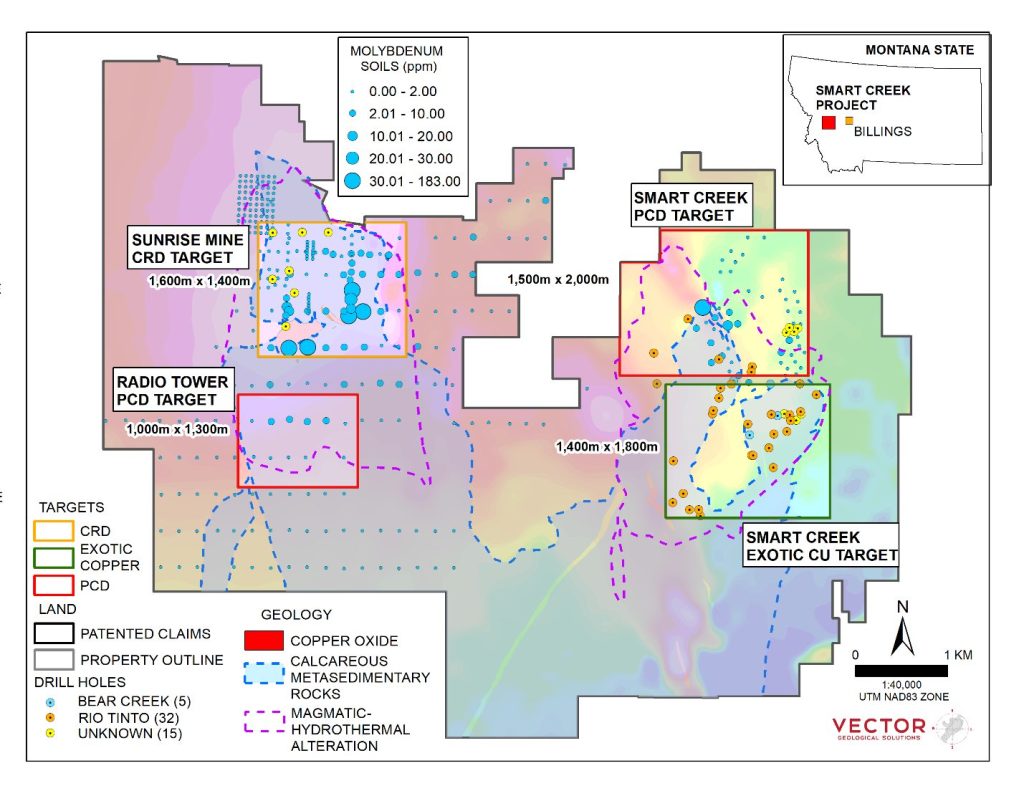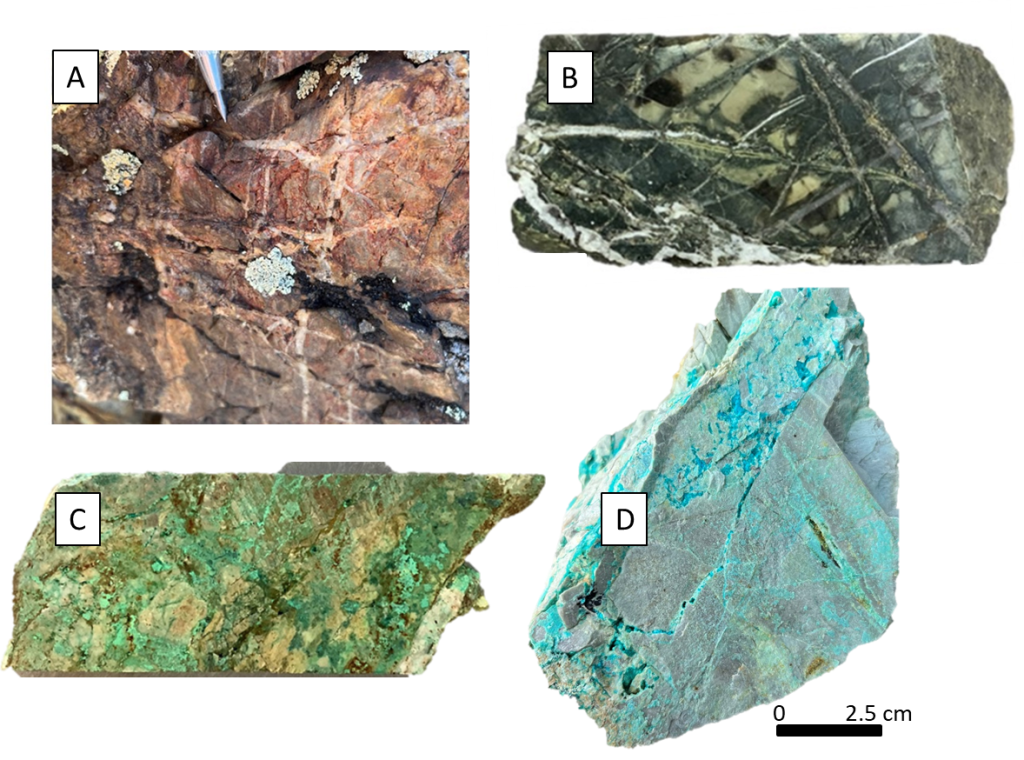Smart Creek Project
At the Smart Creek Project, Domestic Metals is focused on four robust zones of alteration and mineralization areas/domains that represent compelling exploration targets including the porphyry copper targets previously tested by Rio Tinto. Domestic Metals’ team recognized preservation of the host stratigraphy, which provides the opportunity for additional porphyry (and related) targets, including structurally controlled/replacement style gold targets at the Sunrise mine (Figure 1).
In addition, exploration opportunities are recognized on the Smart Creek project with potential for carbonate replacement style mineralization (CRD) at the Smart Creek target and at Sunrise including copper, gold and silver replacement bodies near and associated with the historic Sunrise Mine, as evidenced by widespread marbleization and skarn development associated with manganese oxides and copper oxides in the carbonate metasedimentary rocks of the Helena formation.
The Smart Creek copper target remains a high-priority target with widespread, high grade copper oxides (and sulphides) which outcrop at surface. This mineralization is cut by numerous historic drill holes, with multiple copper intercepts from surface e.g, 109.73m @ 0.75% Cu; 18.74 g/t Ag (SMCR0022; see below)(1,2).
The Smart Creek Project was optioned from Rio Tinto (see August 20, 2024 News Release). Smart Creek is accessible year-round via highway and gravel roads, and is located 100 km southeast of Missoula, Montana (Figure 1). Gold-Copper exploration potential is considered excellent at Smart Creek:
A total of 52 previous drill holes (7 at Sunrise, 45 at Smart Creek). Recent drilling in 2022 by Rio Tinto resulted in – copper assay results including a 109.73m @ 0.75% Cu and 18.74 g/t Ag intercept (drill hole SMCR0022; see NR dated August 20, 2024) (1,2).
- Extensive high-grade oxide and sulfide copper mineralization throughout the property. Historical rock samples with copper grades ranging from below detection limits up to 5.64% Cu with historical mining at Smart Creek, Sunrise and at the Henderson Gultch placer mining operations (3,4).
- Historic mining of a gold-copper replacement-style deposit at the Sunrise Mine (5).
- Preservation of the porphyry-skarn-CRD-epithermal environments on the property. Geological mapping observations include exotic copper mineralization, high-sulfidation style gold showings, skarn/CRD replacements, and widespread porphyry-style, mineralization and veins. The property features multiple targets with limited drilling, untested by modern methods.
- A large database of airborne magnetic/radiometric/Induced polarization and historic soil and rock sampling, RC and diamond drilling with significant, untested geochemical anomalies coincident with alteration zones (Figure 3) (2).
- Superb reactive host rocks (Helena Formation calcareous metasedimentary rocks); porphyry intrusions associated with large alteration footprints at Smart Creek and Sunrise (Figures 1-4).
Findings from 2024 Exploration Program
The Smart Creek project hosts significant mineralization corresponding to at least 3 related styles of copper and gold deposit models, including porphyry copper-gold (PCD; Smart Creek and Radio Tower), carbonate replacement deposits (CRD; Sunrise Mine and Smart Creek), structurally controlled epithermal gold (Sunrise Mine), and exotic or remobilized copper deposits formed by supergene processes (Smart Creek Exotic Copper Target; Figures 1-4). With the exception of the copper potential at Smart Creek, mineralization at Smart Creek is the result of magmatic-hydrothermal fluid flow driven and focused by Eocene intrusions and trapped by reactive Helena Formation carbonate-rich metasedimentary rocks which ultimately produced the following opportunities.
Target Opportunities
Smart Creek PCD Target:
Drilling by the previous operators did not attain target depth in the western margin of the Smart Creek area which is characterized by 1) significant copper (and molybdenum) soil anomalism, 2) a major induced polarization chargeability anomaly (Figures 1-4). Hence, the Mo soil anomaly adjacent to the extensive exotic copper has not been tested (Figure 2). Norden Crown has reason to believe that the grades may be high due to 1) the quality of the reactive carbonate host rocks (Helena Formation), 2) widespread skarn, marble and quartz veins which are consistent with the distal parts of a porphyry and 3) presence of an unreactive cap rock aquitard unit (Missoula Group). Cap rocks are known to increase grades in porphyry copper deposits by forcing fluids into more reactive adjacent units. An analogous mineralized system is the Resolution copper deposit (Arizona) where high grade carbonate and diabase host rocks are “super-charged” due to fluid flow channelized by unreactive quartzite5,6. This target at Smart Creek is untested by drilling.
Radio Tower Target:
A second porphyry copper opportunity has been recognized in the south part of the Sunrise mine area (Figures 1-3). Norden Crown geologists have recognized intense marble alteration outcropping in an area underlain by anomalous Cu-Mo-Mn in reconnaissance soil data, as well as a strong IP chargeability high in a historic single geophysical reconnaissance line (Figure 3). The dimensions of the target are 1000m by 1300m defined by the alteration mapping, IP and limited soil data (Figure 3). The strong marble alteration zone is flanked by more distal dolomite alteration and the entire area is underlain by reactive Helena Formation banded carbonates. The Robinson Mine, in Eastern Nevada is an analogous magmatic-hydrothermal system and contains high-grade ore hosted by chemically reactive carbonate host rocks6,7.
Sunrise Structurally-Controlled/Epithermal Gold:
Carbonate replacement Targets (2+ target areas):
Target Opportunities
The Smart Creek area is underlain by widespread copper oxides/carbonates at surface outcrops/subcrops as well as defined in RC drilling (Figure 1). This target area sits 1 km east of the Smart Creek hypogene porphyry target defined by IP chargeability and soil Mo and Cu (Figures 1 and 2). The dimensions of the copper oxide body measure 900m by 400m (plan) and up to 75m depth, defined by historic drilling (Figures 1-3). The direct analogy for the copper footprint at Smart Creek is the recently active Carlota mine in eastern Arizona (50 Mt @ 0.5% Cu6,8,9).
Exploration Plan
Geological mapping
LiDAR
Induced Polarization Ground Geophysics (“IP”)
Airborne EM (electro-magnetic) Geophysics
Geochemistry
Notes:
- Composite intervals are calculated using length weighted averages based on a combination of lithological breaks and copper, gold, and silver geochemical assay. All intervals reported are core lengths, and true thicknesses are yet to be determined. Mineral resource modeling is required before true thicknesses can be reliably estimated. Composite drill intercepts are reported at minimum copper grades of 0.1% copper to a minimum of 3.5 meters and include up to 3.5 meters of internal dilution.
- Data disclosed in this news release includes historical drilling results and surface rock sampling results as well as information derived from historic drill results. Neither the Qualified Person (described below) nor Norden Crown has undertaken any independent investigation of the sampling, nor have they independently analyzed the results of the historical exploration work in order to verify the results. Norden Crown only considers these historical data relevant as the Company is using this data as a guide to develop future exploration programs. The Company’s future exploration work on the Project will include verification of the exploration data by its Qualified Person.
- There are a total of 38 surface rock samples at Smart Creek. The copper grade in these samples ranges from below detection limit to 5.64% copper with a mean value of 1.06% Cu.
- Emmons, W.H., and Calkins, F.C., 1913. Geology and Ore Deposits of the Philipsburg Quadrangle, Montana. United States Geological Survey Professional Paper #78.
- Hehnke et al., 2012, Geology and Exploration Progress at the Resolution Porphyry Cu-Mo Deposit, Arizona, Society of Economic Geologists, Inc. Special Publication 16, p. 147–166.
- The nearby mines provide geologic context for Nordin’s Smart Creek Property, but this is not necessarily indicative that the properties host similar tonnages or grades of mineralization.
- Maher, D., 1995, Evolution of jasperoid and hydrothermal alteration at Veteran Extension in the Robinson (Ely) porphyry copper district, Nevada, MSc thesis; Oregon State University; 175 pages.
- https://kghm.com
- Niemuth, N.J., 1992, Arizona Copper Reserves Open-File Report 92-11 July, 1992, Arizona Department Of Mines & Mineral Resources, 73 pages.





